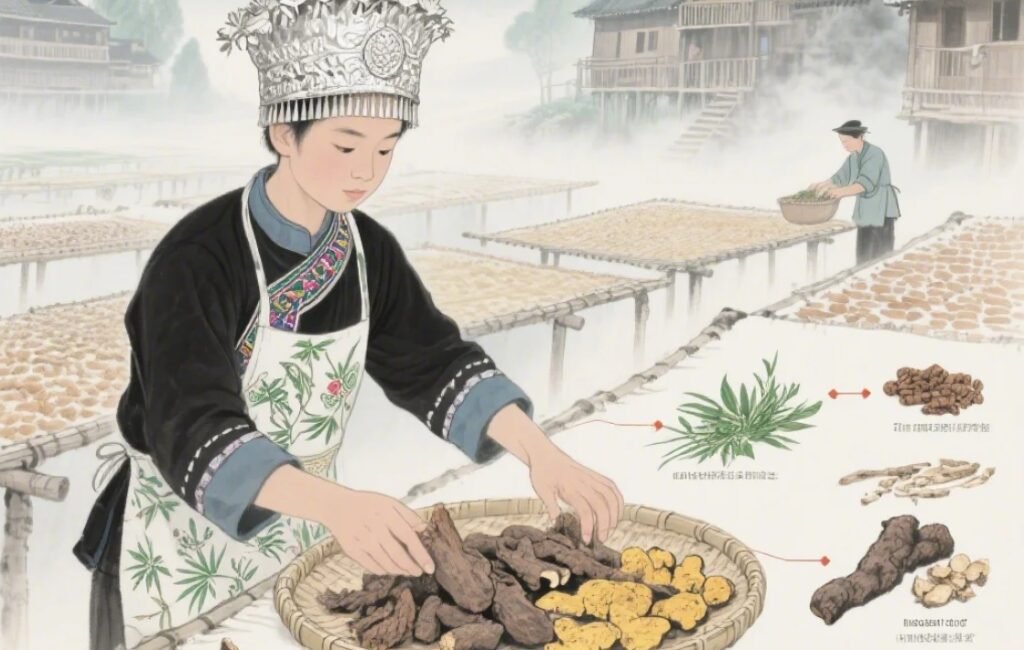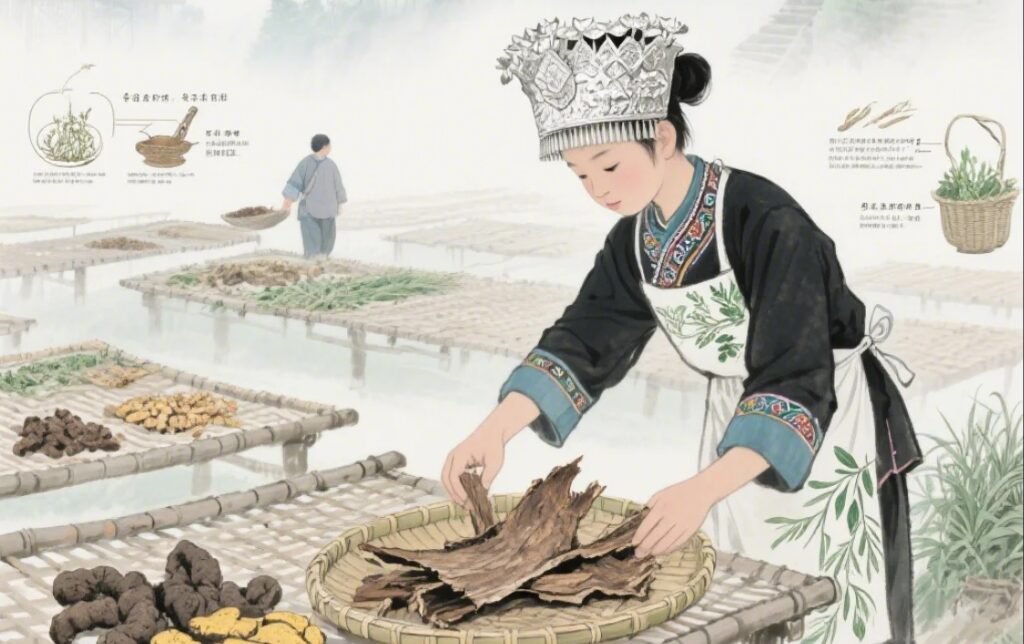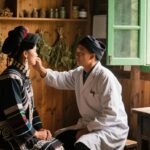Mengshan Dawa (Liver Cirrhosis)
[Overview]
In Miao medicine, liver cirrhosis is referred to as Mengshan Dawa. It is believed to result from the chronic, recurrent attacks of liver frame diseases. Causes such as emotional distress, alcohol overconsumption, and parasitic toxin infections lead to liver frame dysfunction, impairing the storage of qi and blood and subsequently affecting other visceral organs. The primary symptoms include tenderness in the liver region, palpable masses, acid regurgitation, poor appetite, abdominal distension, and painful diarrhea.
Traditional Chinese Medicine (TCM) considers cirrhosis to be caused by emotional disturbance, improper diet, excessive alcohol intake, infection with schistosoma, or unresolved illnesses such as jaundice, hypochondriac pain, and abdominal masses. These factors result in liver qi stagnation, blood stasis, and internal fluid retention, leading to symptoms like abdominal masses, drum-like distention, yellow complexion, and lower limb edema. It falls under the TCM category of “guzhang” (drum distension).
From the perspective of Western medicine, cirrhosis is characterized by hepatic fibrosis, widespread necrosis of hepatocytes, nodular regeneration of residual liver cells, connective tissue proliferation, and fibrous septum formation. This ultimately leads to structural disruption of the hepatic lobules, pseudolobule formation, and progressive liver deformation and hardening.
[Hu Hou Ji Peng – Miao Medicine Symptoms]
Patients with Mengshan Dawa often have a history of hepatitis, malnutrition, or alcoholism. Clinical signs include dull pain and bloating in the liver area, borborygmi, diarrhea, fatigue, emaciation, hepatosplenomegaly, xiu diao fang (jaundice), purplish tongue with petechiae, etc. This condition is classified as a minor syndrome in Miao medicine and can be divided into two subtypes: cold meridian Mengshan Dawa and hot meridian Mengshan Dawa. The former corresponds to the early stage of the disease, while the latter represents the advanced stage.

[Ai Jiang Duo – Etiology]
According to Miao medicine, the liver frame is one of the body’s primary structures for supplying materials. It stores qi and blood, produces bile and nutrients, and facilitates their storage and distribution. Mengshan Dawa arises when factors such as emotional distress, alcohol abuse, or parasitic infections damage the liver frame, impairing its ability to store qi and blood. This dysfunction spreads to other internal organs. Conversely, dysfunction in other organs can affect qi and blood dynamics and thereby cause liver pathology.
[Geng Duo Meng – Pathogenesis]
The disease may stem from unresolved jaundice, hypochondriac pain, or abdominal masses; from emotional imbalance; dietary excess; or schistosoma infection. These lead to damage of the liver and spleen, impaired spleen transport function, water-damp accumulation in the abdomen, stagnation of qi movement, poor blood circulation, and internal generation of blood stasis. This stasis blocks liver collaterals, and over time, damages the liver, spleen, and kidneys. Symptoms include abdominal distension, hepatic pain, palpable masses, and jaundice.
[Key Points in Diagnosis]
Diagnostic Criteria
(1) The hallmark of this disease is pain in the liver region and the presence of a palpable mass. Mild cases may be asymptomatic, while severe cases exhibit significant liver dysfunction.
(2) Associated symptoms may include lower limb edema, jaundice, abdominal distension, acid regurgitation, and belching.
(3) A history of hepatitis, malnutrition, alcoholism, schistosomiasis, or other factors causing liver frame damage may be present.
Relevant Examinations
Blood tests, liver function tests, pathogen screening, ascitic fluid analysis, X-ray, liver ultrasound, abdominal CT or MRI can be used for initial screening. Liver biopsy and immunological testing can support diagnosis.
[Differential Diagnosis]
Mengchong Dang (Hypochondriac Pain)
Both Mengchong Dang and Mengshan Dawa can present with pain beneath the ribs. Mengchong Dang is typically caused by constitutional weakness, emotional stress damaging the meridians, dietary indiscretions affecting the gastrointestinal tract, internal damp-heat, or trauma resulting in qi stagnation and blood stasis. Its primary symptom is unilateral or bilateral hypochondriac pain.
In contrast, Mengshan Dawa results from liver, spleen, and kidney damage with internal fluid retention. Early symptoms include hypochondriac pain and abdominal discomfort, which worsen after meals. As the condition progresses, abdominal distension becomes pronounced, accompanied by sallow complexion, fatigue, poor appetite, visible abdominal veins, emaciation of limbs, lower limb edema, oliguria, and bleeding tendencies.
[Syndrome Classification and Treatment]
Cold Meridian Mengshan Dawa
Mengli Duo (Syndrome Manifestation): Early stage symptoms are mild. Liver function tests may be normal or slightly abnormal. Occasional dull pain in the liver region, fatigue, weight loss, borborygmi, diarrhea.
Xing Leng (Meridian Classification): Cold meridian, cold disorder.
Jia He Meng (Treatment Principle): She wa wo (drain downward and promote diuresis).
Ou Duo Xi Jia, Fang Ou (Prescriptions and Explanation):
Yang di ga (Adenophora root, yang di ga) 50g
Wo li lüe (Weeping forsythia fruit, wo li lüe) 20g
Zhen xiang e (Bush cherry seed, zhen xiang e) 20g
Decoction for oral use.
Yang di ga: Mildly cold, sweet; enters hot and chronic meridians. Nourishes yin, clears heat, moistens the lungs, dissolves phlegm, and generates fluids.
Wo li lüe: Cold and bitter; enters hot meridians. Clears heat, detoxifies, reduces swelling.
Zhen xiang e: Warm and slightly bitter; enters cold meridians. Promotes urination and reduces swelling.

Hot Meridian Mengshan Dawa
Mengli Duo (Syndrome Manifestation): Advanced symptoms become more severe, with prominent abdominal veins, worsening jaundice, and signs of bleeding.
Xing Leng (Meridian Classification): Hot meridian, hot disorder.
Jia He Meng (Treatment Principle): Hang ben diu xiang (promote qi movement and resolve stasis), wa wo (promote diuresis).
Ou Duo Xi Jia, Fang Ou (Prescriptions and Explanation):
Sou dang suo (Alternanthera, sou dang suo) 16g
Bi duo zi qi (Jujube, bi duo zi qi) 20g
Li ba jiang (Plantain herb, li ba jiang) 15g
Jia qiang (Goldenseal herb, jia qiang) 15g
Wo bi, wo shou (Black atractylodes, white atractylodes) 10g each
Ji jia nuo (Bambusa blossom, ji jia nuo) 20g
Decoction for oral use.
Sou dang suo: Warm, sour, slightly bitter and astringent; enters cold meridians. Detoxifies, disperses stasis, and drains dampness.
Bi duo zi qi: Sweet and warm; enters cold meridians. Tonifies spleen, nourishes qi and blood, calms the spirit.
Li ba jiang, Jia qiang: Cold and bitter/astringent; enters hot meridians. Clears heat, promotes urination, cools blood, detoxifies.
Jia qiang: Cold and bitter; clears heat, detoxifies, drains dampness, relieves pain.
Wo bi, Wo shou: Cold and bitter; enters hot meridians. Tonifies kidneys and promotes diuresis.
Ji jia nuo: Warm, slightly sweet and pungent; enters cold meridians. Tonifies qi and yin, activates blood.
[Prevention and Care]
Regulate emotions and avoid excessive worry.
Protect against wind-cold; adapt to seasonal temperatures.
Adjust diet; avoid smoking and alcohol.
Moderate lifestyle; combine activity and rest. Live with a regular routine, balancing exertion and relaxation.
[Notes]
Miao medicine regards the liver frame as an essential support structure for the brain, stomach, heart, and other organ frames. It plays a central role in supplying material energy to the body and maintaining mutual generation, regulation, and dependence among organs. This disease, caused by emotional strain, alcohol overuse, or parasitic infections, impairs the liver frame and disrupts the functions of other organs. Treatment is based primarily on promoting qi circulation, resolving blood stasis, and promoting diuresis.


Leave a Reply